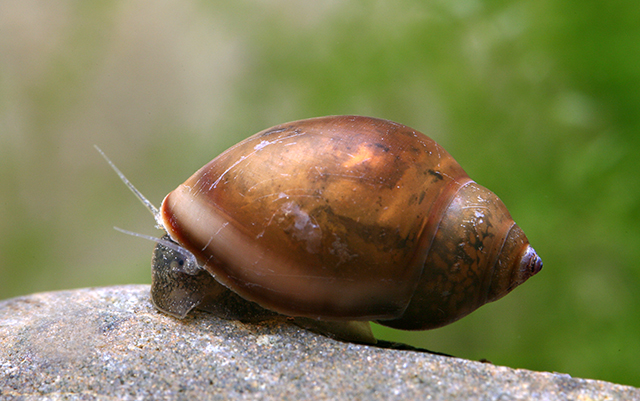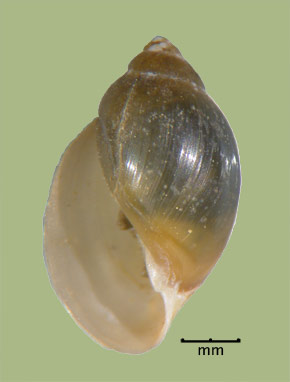Physella" gyrina, ancillaria, etc.
> Habitat & Distribution
Populations of P. gyrina range from the Great Valley of Virginia north through New England to Quebec, west to California and the Northwest Territories (Clarke 1981, Jokinen 1992, Dillon and Wethington 2004). Physa gyrina has also been introduced to the British Isles (Anderson 1996). Populations are widespread in drainages of the Ohio, the Tennessee/Cumberland, and the Great Plains states. They become less common further south, disappearing from the warmer waters of the Carolinas and Georgia. Our single east Georgia record - a spring in a DeKalb County Park, is probably an accidental introduction.
Populations of Physa gyrina may be found in almost any permanent or intermittent freshwater habitat type, including ponds, lakes, creeks and rivers. Substrata occupied include mud, sand, gravel, rock, and plants (Jokinen 1992, Dillon 2000, Dillon and Wethington 2004, Stewart 2006). In northern states, populations are often very abundant in macrophyte stands (Pip 1991, Brown 1997). FWGNA incidence rank I-5.
> Ecology & Life History
Physa gyrina seems to thrive under a variety of environmental conditions, and is considered a dietary and habitat generalist (Brown 1982, Dillon 2000). Jokinen s (1987) analysis of the distribution of P. gyrina (listed as P. ancillaria) in Connecticut and New York led her to classify it as an A-B tramp, typically present only in the more species-rich communities. Dillon s (2000: 360-363) USR reanalysis of these data suggested that P. gyrina populations in Connecticut might be S-adapted, common in poor but stable environments, demonstrating low reproductive effort relative to body size.
Populations of P. gyrina can consume tremendous quantities of detritus, diatoms, filamentous algae, fungi, and living animal and vascular plant material (Newman et al. 1996). Effects have been documented on algal and macrophyte biomass, as well as primary producer community structure (Hunter 1980, Sheldon 1987). Physa gyrina may itself serve as an important prey for crayfish, fish, and other predaceous invertebrates and vertebrates. There is experimental evidence that crayfish can measurably reduce P. gyrina densities (Hanson & Chambers 1995).Physa gyrina populations have evolved a variety of antipredator adaptations, including detecting predators through chemical cues and subsequently avoiding them by crawling to structurally-complex protective habitats and reducing activity levels (Turner et al. 2000, McCarthy and Dickey 2002). Turner & Montgomery (2009) suggested that the distribution of P. gyrina in Western Pennsylvania may reflect some adaptation to predator avoidance.
Physa gyrina populations also exhibit phenotypic plasticity with respect to shell shape and thickness, thickness increasing and apertures widening under predation pressure by shell-crushing fish. Apertures seem to narrow in habitats with crayfish that extract snails from their shells (DeWitt et al. 2000).
Physa gyrina is more pollution-tolerant than most freshwater snails (Clarke 1981). However, a survey by Pip (2000) revealed declines in Manitoba from 1978 to 1998, presumably due to habitat degradation caused by intensive agriculture and mining activities. Harman (2000) also found that P. gyrina went extinct in Oneida Lake, New York State, following years of anthropogenic eutrophication.
In the lab, P. gyrina reproduces at a median age of 11-12 weeks, significantly behind P. acuta, demonstrating significantly lower weekly mean fecundity as well (Dillon et al. 2004). A variety of life history patterns have been reported in the field, including types A, B, and G (McKillop 1985, Jokinen 1992, Hanley and Ultsch 1999, Dillon 2000: 156-162). Levri et al. (2014) analyzed growth rates and mortalities in laboratory populations identifed as being in the "Physella gyrina group" as a control for experimental populations of Potamopyrgus antipodarum.
> Taxonomy & Systematics
A detailed study of the shell morphology of Physa gyrina, together with a review of ecology and life history of populations in Europe, has been contributed by Cieplok et al (2022).
Although rather different creatures biologically, significant taxonomic confusion has existed historically between Physa gyrina and Physa acuta, under the latter s junior synonyms heterostropha and integra. (See my essay of 14Oct08 from the link below.) The two species demonstrate rather different penial morphologies and do not interbreed in the lab, P. gyrina reproducing significantly later than P. acuta, at a lower mean weekly fecundity (Dillon et al. 2004). See my essay of 12July11 for a review of reproductive isolation in the Physidae.
The shell morphological variability exhibited by physid populations (DeWitt et al. 2000) has led to the description of a large number of species that will prove to be junior synonyms of P. gyrina. Dillon and Wethington (2004) reported no postzygotic reproductive isolation between populations of P. gyrina, P. ancillaria (Say, 1825), P. aurea Lea 1838, P. microstriata Chamberlain and Berry 1930 and P. utahensis Clench 1925 collected at or near their type localities. The results of the Dillon and Wethington (2006) genetic survey of Michigan physid populations suggested that P. sayi (Tappan, 1838) and P. parkeri Currier 1881 are synonyms of P. gyrina as well. Additional junior synonyms probably include globosa Haldeman 1841, lordi Baird 1863, and magnalacustris Walker 1901.
Until recently it was believed that the North American Physidae numbered more than 40 species, and a variety of elaborate classification schemes have been proposed (eg, Te 1978, 1980; Burch 1989). Physa gyrina has lately been referred to the genus Physella. It is now clear that most of this nominal diversity is attributable to phenotypic plasticity, and that the true number of American species is closer to ten (Wethington 2004, Wethington & Lydeard 2007). The simple two-genus system favored by earlier workers (Walker 1918) would seem sufficient, all southeastern species referable to the genus Physa. See my essay of 12Oct07 (below) for more on the systematics of the Physidae.
> Maps and Supplementary Resources
- Physa distribution in drainages of The Ohio (2019)
- Physa gyrina distribution in Atlantic drainages (2023)
- Physa distribution in Georgia and the Florida panhandle (2025)
- Physa distribution in the Tennessee/Cumberland (2022)
- Physa gyrina and Physa acuta in The Great Plains (2024)
- Photo of living Physa gyrina, courtesy of Chris Lukhaup.

> Essays
- The phylogenetic analysis of Wethington & Lydeard prompted me to review The Classification of the Physidae in my post of 12Oct07.
- I reviewed the longstanding taxonomic confusion between Physa acuta and Physa gyrina in my essay of 14Oct08, "Backwards Snails Backwards."
- The Dillon et al. (2011) paper on the evolution of reproductive isolation in Physa served as a jumping-off point for my blog post of 12July11, "What is a Species Tree?"
- For an historical perspective on the classification of the Physidae, see my three part series on the life and work of George A. Te: To Identify a Physa 1971, To Identify a Physa 1975, and To Identify a Physa 1978.
- See my post of 26Sept14 for good, comparative figures illustrating "The egg masses of freshwater pulmonate snails."
- See my post of 2June24, "The Twelve Phascinating Physa of Bliss" for a couple good figures illustrating the shell difference between P. gyrina and P. acuta.
> References
Anderson, R. 1996. Physa gyrina (Say), a North American freshwater gastropod new to Ireland, with a key to the British Isles Physidae. Irish Naturalists Journal 25:1-6.
Brown, K.M. 1979. The adaptive demography of four freshwater pulmonate snails. Evolution 33:417-432.
Brown, K.M. 1982. Resource overlap and competition in pond snails: an experimental analysis. Ecology 63:412-422.
Brown, K.M. 1997. Temporal and spatial patterns of abundance in the gastropod assemblage of a macrophyte bed. Ameri Malac Bull 14:27-33.
Burch, J.B. 1989. North American Freshwater Snails. Malacological Publications, Hamburg, Michigan.
Burgarella, C. et al. (2015) Molecular evolution of freshwater snails with contrasting mating systems. Mol. Biol. Evol. 32(9): 2403 - 2416.
Cieplok, A., R. Anderson, M. Gawlak, T. Kaluski, & A. Spyra (2022) Morphological diversification of alien and native aquatic snails of the genus Physa and Aplexa (Gastropoda: Physidae) of Western and Central European range. Zootaxa 5168 (2): 101 - 118.
Clampitt, P.T. 1970. Comparative ecology of the snails Physa gyrina and Physa integra (Basommatophora: Physidae). Malacologia 10: 113-151.
Clarke, A.H. 1981. The Freshwater Molluscs of Canada. National Museum of Natural Sciences, National Museums of Canada, Ottawa, Canada.
DeWitt, T.J., B.W. Robinson, and D.S. Wilson. 2000. Functional diversity among predators of a freshwater snail imposes an adaptive trade-off for shell morphology. Evol Ecol Res 2000:129-148.
Dillon, R.T., Jr. 2000. The Ecology of Freshwater Molluscs. Cambridge University Press, Cambridge, United Kingdom.
Dillon, R. T., Jr., C. E. Earnhardt & T. P. Smith (2004) Reproductive isolation between Physa acuta and Physa gyrina in joint culture. Am. Malac. Bull. 19: 63-68.
Dillon, R.T., Jr. and A.R. Wethington. 2004. No-choice mating experiments among six nominal taxa of the subgenus Physella (Basommatophora: Physidae). Heldia 6:1-10. [PDF]
Dillon, R.T., Jr. and A.R. Wethington. 2006a. The Michigan Physidae revisited: A population genetic study. Malacologia 48: 133-142. [PDF]
Dillon, R. T., A. R. Wethington, and C. Lydeard (2011) The evolution of reproductive isolation in a simultaneous hermaphrodite, the freshwater snail Physa. BMC Evolutionary Biology 11:144. [PDF] [html]
Hanley, R.W., and G.R. Ultsch. 1999. Ambient oxygen tension, metabolic rate, and habitat selection in freshwater snails. Arch Hydrobiol 144:195-214.
Hanson, J.M., and P.A. Chambers. 1995. Review of effects of variation in crayfish abundance on macrophyte and macroinvertebrate communities of lakes. ICES Marine Science Symposium 199:175-182.
Harman, W.N. 2000. Diminishing species richness of mollusks in Oneida Lake, New York State, USA. Nautilus 114:120-126.
Hunter, R.D. 1980. Effects of grazing on the quantity and quality of fresh water aufwuchs. Hydrobiologia 69:251-260.
Jokinen, E. 1987. Structure of freshwater snail communities: Species-area relationships and incidence categories. Amer. Malac. Bull. 5: 9 - 19.
Jokinen, E.H. 1992. The Freshwater Snails (Mollusca: Gastropoda) of New York State. NY State Mus Bull 482, Albany, New York.
Jokinen, E.H. 2005. Pond molluscs of Indiana Dunes National Lakeshore: then and now. Amer Malac Bull 20:1-9.
Levri, E.P., A.C. Krist, R. Bilka, and M.F. Dybdahl (2014) Phenotypic plasticity of the introduced New Zealand mud Snail, Potamopyrgus antipodarum, compared to sympatric native snails. PLoS ONE 9(4):e93985, 1-6.
McCarthy, T.M., and B.F. Dickey 2002. Chemically mediated effects of injured prey on behavior of both prey and predators. Behaviour 139:585-602.
McKillop, W.B. 1985. Distribution of aquatic gastropods across the Ordovician dolomite -Precambrian granite contact in southeastern Manitoba, Canada. Can J Zool 63:278-288.
Newman, R.M., W.C. Kerfoot, and Z. Hanscom III. 1996. Watercress allelochemical defends high-nitrogen foliage against consumption: effects on freshwater invertebrate herbivores. Ecology 77:2312-2323.
Pip, E. 1991. Macrophyte and associated mollusc communities in a Meteor Crater Lake on the Precambrian Shield of Manitoba. Can Field-Nat 105: 483-487.
Pip, E. 2000. The decline of freshwater molluscs in southern Manitoba. Can Field-Nat 114:555-560.
Sheldon, S.P. 1987. The effect of herbivorous snails on submerged macrophyte communities in Minnesota USA lakes. Ecology 68:1920-1931.
Stewart, T.W., and R.T. Dillon, Jr. 2004. Species composition and geographic distribution of Virginia's freshwater gastropod fauna: a review using historical records. Amer Malac Bull 19:79-91.
Stewart, T.W. 2006. The freshwater gastropods of Iowa (1821-1998): species composition, geographic distributions, and conservation concerns. Amer. Malac. Bull. 21: 59 -75.
Te, G. A. 1978. The systematics of the family Physidae (Basommatophora: Pulmonata). Ph.D. Dissertation, University of Michigan, pp. 325.
Te, G. A. 1980. New classification for the family Physidae (Pulmonata: Basommatophora). Arch. Moll. 110:179-184.
Turner, A.M., R.J. Bernot, and C.M. Boes. 2000. Chemical cues modify species interactions: the ecological consequences of predator avoidance by freshwater snails. Oikos 88:148-158.
Turner, A. M. & S. L. Montgomery. 2009. Hydroperiod, predators and the distribution of physid snails across the freshwater habitat gradient. Freshwater Biology 54: 1189-1201.
Walker, B. 1918. A synopsis of the classification of the freshwater molusca of North America, north of Mexico. Univ. Mich. Museum of Zool. Misc. Publ. 6.
Wethington, A. R. 2004 Phylogeny, taxonomy, and evolution of reproductive isolation in Physa (Pulmonata: Physidae) Ph.D. dissertation, University of Alabama, Tuscaloosa.
Wethington, A. R. & C. Lydeard 2007. A molecular phylogeny of Physidae (Gastropoda: Basommatophora) based on mitochondrial DNA sequences. J. Molluscan Stud. 73: 241 - 257 [PDF].








